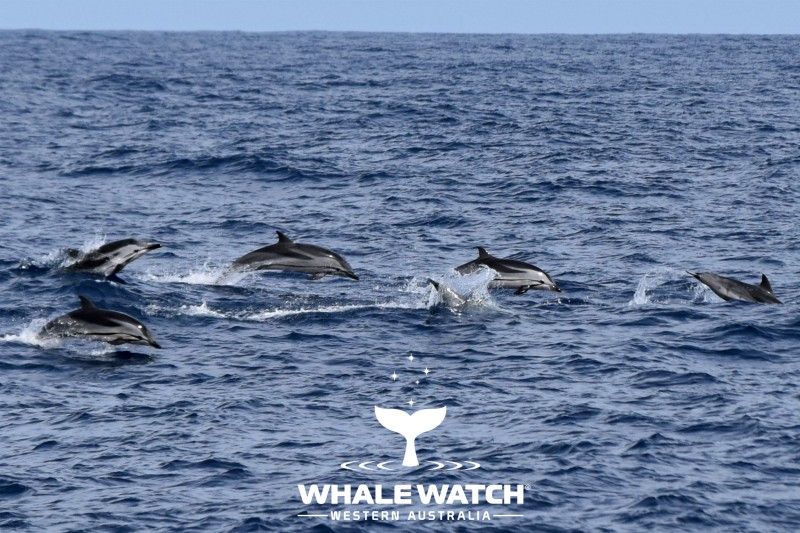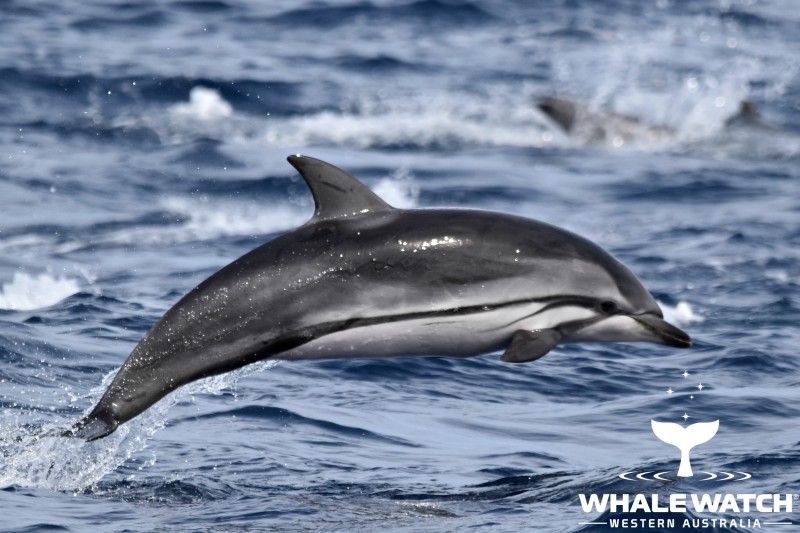The Striped Dolphin or Stenella coeruleoalba is a stunning dolphin species that often travel in enormous pods of 500+ individuals. Streamlined, elegant and beautifully patterned the Striped Dolphin is never hard to miss in a crowd and carry with them a rather gorgeous personality.
During our Bremer Bay Orca and Perth Canyon Blue Whale seasons we spend much of our time on the continental shelf which is the perfect place to look for Striped Dolphins. They are an offshore or pelagic species which spend their life travelling to different feeding grounds, often many hundreds of kilometres from one fridge to the next. Travelling like this is best done with company and they are known to travel in super pods of up to 1,000 individuals or more creating a spectacular scene.

The movement of a super pod can be sighted from many kilometres away as the frothing of white water and hundreds of dolphins simultaneously porpoising out of the ocean creates an enormous amount of surface activity and noise which is unmistakable and often spreads over many hundreds of meters.
The pods are unique in their structure with three main pods being recognised with anywhere from 100 to 1,000+ travelling together in their pod structure. The calves will stay with mum in the adult pod until they are coming into their “teenage” years and join up with the sub-adult pods.
- Sub-adult (juveniles)
- Adult (breeding age)
- Non-breeding
Specialising in hunting for pelagic fish species, squid and krill they will feed during the day or night dependant on the food they are targeting. Some areas provide better feeding in the evening as the prey move up from the depths and into shallower areas of the water column with 200 meters or less being a preferred dive range for the Striped Dolphin with a maximum dive of up to 10 minutes.

- Distribution is worldwide in temperate to tropical offshore waters
- Lifespan is up to 60 years
- Females will have one calf every 3-4 four years who is at birth 1 meter long and 11 kilograms
- Males are physically mature at 16-20 years, 2.5 meters long and 160 kilograms
- Females are physically mature at 14-18 years, 2.4 meters long and 150 kilograms
- Gestation is 12 months and the calf will be weaned after 16 months
The Striped Dolphin numbers worldwide are healthy, the Australian population could exceed 10,000 mature adults but there is no exact population estimates as sightings in Australia are not frequent enough. The main concern for this species is becoming caught in fishing gear, especially when targeting the same prey as commercial fishing. Another important factor which cannot be ignored is the continued Taiji dolphin drive hunts which captures Striped Dolphins and other dolphin species for meat consumption and sold to captive marine theme parks around the world.
The Striped Dolphin population within Australian waters are relatively safe compared to other populations worldwide, but we must continue to monitor them as best we can and achieve a better understanding of Australian population estimates and their movements in our waters. To help Striped Dolphins around the world there are a couple of things you can do to make a difference.
- Buy your seafood locally, over 70% of seafood consumed in Australia is imported which often means fishing methods are used which are not as stringent as Australian standards. Buying fresh, local seafood means you will be supporting your local community, local fishermen fish with the future in mind and want to protect their environments to ensure that they and their families have a future in fishing. Support your Aussie fishermen and you will also be encouraging a better future for local and international fish populations and sealife.
- Stop dolphin captivity, do not visit theme parks or dolphinariums that continue to keep captive marine mammals. Travelling internationally can be a fantastic way to view different wildlife in their natural environment which should be encouraged. Going to a theme park or dolphinarium to see a show or view captive dolphins is encouraging the continued sale and breeding programs of these establishments around the world.
We are very fortunate in Australia to have some of the healthiest and most wildlife filled oceans surrounding our nation creating the perfect opportunity to see dolphins in the wild. For seafood lovers this means we can enjoy a sustainable fishing industry when supporting local and responsible fishing families. Education is key and the more we understand about the wildlife around us the better we can protect them by making the right choices.






